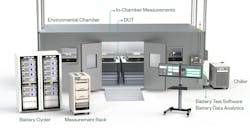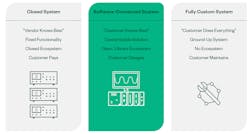No Playbook? No Problem! A Take on EV Battery Test
What you'll learn:
- How will the typical battery lab setup change?
- Test management: customization and scalability.
- The data-analytics aspect to complex battery test.
Vehicle electrification has come a long way since starting as a promise of zero emissions, but we’re still constantly finding ourselves in these moments of doubt. It happens when new requirements come in, when there’s a new battery chemistry we need to test, when we’re asked to increase the performance and range, or even when regulations and standards get updated.
Trusting we can figure it out can give us a head start. However, many times, we’ll find ourselves frustrated at the lack of solutions that can match our ability to figure things out at the speed we need to get the job done. What do we do in those cases? Let’s start with what we know about vehicle electrification.
Know What to Anticipate
Even with the lack of a playbook to follow, we know that safety and performance reign supreme in electric-vehicle (EV) battery validation, no matter how requirements, regulations, or customer demands change. Bound by uncompromising safety, we squeeze every mile out of the battery. Even as the designs, topologies, and chemistries evolve, we’ll see four significant elements changing in our typical battery lab setup (Fig. 1):
- The battery itself as the device under test (DUT)
- Measurements we need to make (on DUT, chamber, or lab)
- Power needs (battery cycler)
- The role of data beyond the lab
If we’re able to anticipate our requirements, we’ll be best positioned to future-proof our test cells and select the right technology that can match our ability to solve the test challenges. How do we start?
Know Where You Are
Consider the measurements needed to test a single battery. You’ll typically need kilowatts of power to charge/discharge the battery following your test profiles, and to take measurements from the battery management system (BMS) on an automotive bus like CAN.
In this starting scenario, you need to focus on customizing the test so that the cycling profiles are followed and the data from the test can be used to understand how the battery behaves to maximize its output. You’ll then be working with the most basic needs for the four elements I mentioned above to help minimize any concerns.
The next scenario is having a bigger, complex, walk-in test cell in which you have more than one battery. In such a scenario, the biggest need is for scalability of the test—now you have measurements from multiple BMS, from the battery pack/module itself, and from the chamber. Your power needs increase, and you need to manage the charge/discharge on multiple batteries, using multiple power supplies and programmable loads (or bidirectional power supplies). This creates the need to integrate power management into your test.
In these two examples, a lot of the focus remains on the test and the test data. To scale beyond that, automakers are moving up to labs with many of these complex test cells where a need for facility management arises on top of test management. As the number and complexity of test cells increases, so does the number of devices under test (DUTs), measurement channels, intricacy of cycling, and amount of power used. Consequently, other challenges emerge, e.g., dissipating the heat from the megawatt-level microgrids that you’re running in your facility.
A lot of automakers are sitting between this and the previous level because they provide a good balance of test results at scale. However, an aspirational level of sophistication beyond this one should be kept in mind when deciding on a battery-test infrastructure investment (Fig. 2).
Know Where You’re Heading
At this aspirational level, we shift focus from testing to pass/fail, to testing for product performance. The main difference here is that your multi-cell facility—and the challenges that come with it—is now built with data as a priority.
Adding data-analytics capability to perform the test automation and facility management, and connecting it to the data outside the lab (e.g., data from the individual battery cells or aftermarket performance data from the EVs already deployed), uncovers insights that help optimize battery performance with uncompromising safety. To get to this level, the flexibility needed with the lab only comes when it’s connected through software, from test to facility management to analytics.
How Do We Get There?
When we’re testing to optimize battery performance, closed solutions become a liability and fully custom systems are too slow to match our “figure it out” pace. The sweet spot is right in the middle, where you can customize on a scalable platform through software (Fig. 3).
When there’s frustration with tools that lack flexibility, speed, or automation capability—or they’re so closed that we can’t get the data we need out of them—we must ground ourselves on the principle of maximizing safety and performance. Then, the answer becomes clear: Data and software should be at the core of our test infrastructure and equipment.
NI has a history of using both data and software to solve highly complex engineering challenges. The company’s solutions sit at the intersection of custom and standard, enabling engineers to focus on innovating and figuring things out, instead of implementation details.



